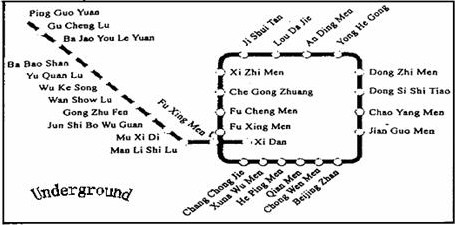阅读理解。

It is said that as the population of a city grows, so do its problems. Pollution, too many cars, and crowded
streets are just a few of these difficulties. One way to help with these problems is city trains. Trains traveling
to different parts of a city mean fewer cars and buses on our roads, cleaner air, and more open streets. In
recent years, cities such as Guangzhou, Shenzhen and Shanghai have all built city train lines.
The first city train line in China was built in Beijing. The oldest part of the train line, from Beijing Zhan to
Ping Guo Yuan was opened in 1969. Its length was 23.6 kilometres. As the city grew after 1980, so did the
need for more trains. A newer train line was built to help move people around the city centre. The 16-kilometre-
long "circle (环形) line" was finished in 1987. Since that time even more train stations have been built and today
the train lines in the city are over 50 kilometres long.
For the 2008 Olympic Games, the trains of Beijing will be very important. It is thought that most of the
people who go to watch the different sports during the Games will travel using trains.
1. The passage tells us about _____.
A. the problems in big cities
B. city trains
C. the history of Beijing
D. 2008 Olympic Games
2. How long was the first train line in Beijing?
A. About 16 kms.
B. About 23 kms.
C. About 33 kms.
D. About 50 kms.
3. In 1977, which of the following places in Beijing could you go to by train?
A. Chao Yang Men.
B. An Ding Men.
C. Che Gong Zhuang.
D. He Ping Men.
4. Which of the following is true?
A. In 2008, the Beijing train line will be nearly 40 years old.
B. The larger population a city has, the fewer problems it faces.
C. More and more cities are building undergrounds for the 2008 Olympic Games.
D. There are 20 stations on the "circle line" in Beijing.

